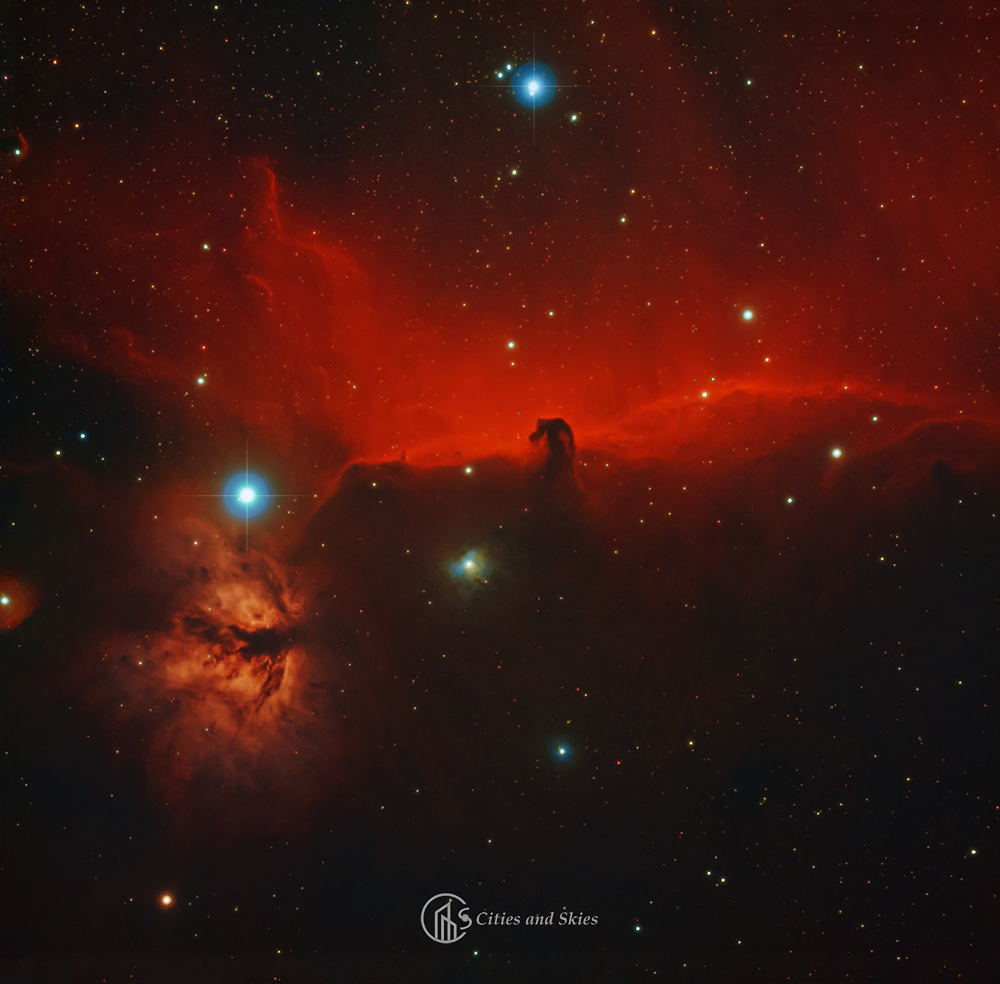Dust in space is abundant at places of star formation like the Horsehead Nebula – which is one of the most photographed celestial objects. It is part of a star formation complex together with the Orion Nebula, but it forms fewer stars and the actual processes are hidden from our eyes by dust in the region. There is a curious interplay here between hot stars and cold gas, small stars and large-scale outflows, fragile molecules and deadly ionizing radiation – destroying molecules and even atoms.
We have learned recently that the hottest stars of spectral type O are extremely rare. In this picture there are two of them, and they are the prime culprits for the spectacular show we see here! Sigma Orionis on the top of the picture is one of the many stars that make the gas clouds shine, against which the silhouette of the dusty Horsehead appears. Mintaka, the westernmost star of Orion’s Belt is on the left. It lights up the Flame Nebula, which also has prominent dust lanes. And there is also a smaller reflection nebula just left of the center, activated by a star that is almost as hot as the other two.
Where does the dust in space come from?
The basic elements (carbon, oxygen, light metals, and other elements up to iron) are formed in stars. A small fraction of the dust grains may already form in the envelopes of cool, red giant stars. Stellar winds and exploding supernovae then enrich the interstellar medium. In the cool, outer space dust grains further condense in dark molecular clouds. While dust is a nuisance to astronomers because it obscures the light, it is also a great tool to study galaxies. The light absorbed by dust is re-emitted as heat in the infrared. As this radiation follows star formation, one may measure the star-forming activity even in very far away galaxies based on how much they radiate in the infrared. Curiously, although the physical processes are very different, the same is true for the radio waves. There is a lot we can learn beyond the visible part of the electromagnetic spectrum!
A cool place to form stars
Dense molecular clouds are ideal places of star formation, but the prodigious radiation from young stars would also destroy the cloud. It is actually hot plasma from young stars that compressed the cold gas and created the Horsehead Nebula, which is dense enough to survive the destructive wave. However, the detailed processes of star formation are still not understood. The infrared observatory SOFIA, which is a Boeing 747SP jetliner carrying a 100-inch diameter telescope, can help with this. Dust in space does not obscure infrared light the same way as it does with visible light. The Horsehead Nebula in fact glows at near-infrared wavelengths, as was demonstrated by the Hubble Space Telescope (and this is a more artistic version of the same picture).
As a final note: while it is not clear who was the first to discover the Horsehead Nebula, it was Williamina Fleming who cataloged it for the first time, when she reviewed photographic plates recorded at Harvard College Observatory. And by the way, talking of O-stars earlier, she was also the one that came up with the first stellar classification scheme. More on that later…
Observing log
A nice full run on 21 February 2021. Revisited on 1 & 2 March, but those nights were shorter. There were strong high altitude winds on 1 March (I guess, from guide instabilities) and clouds came, too. Moon is almost full. On 2 March shooting was finished before moonrise. The Southern skies are only visible from the street front, with lots of disturbing lights.
Horsehead and Flame Nebulae plus NGC2023, 5.3h
Hoogeveen, Netherlands
21 Feb. 2021, 40x180s
1 and 2 Mar. 2021, 20x300s both nights
William Optics GT81, f/5.9
Flattener 6AIII 0.8x
ZWO ASI533MC-P, gain 240, -20 deg.
WO Uniguide 50/200 with ASI120MMmini
iOptron CEM40
Optolong L-eXtreme
ASIair
Bortle~5 (our region; in the town, it should be worse)
Stacked in Astro Pixel Processor in 32-bit mode, which gives more color.
Then moved to 16-bit mode and done the rest in Photoshop.
